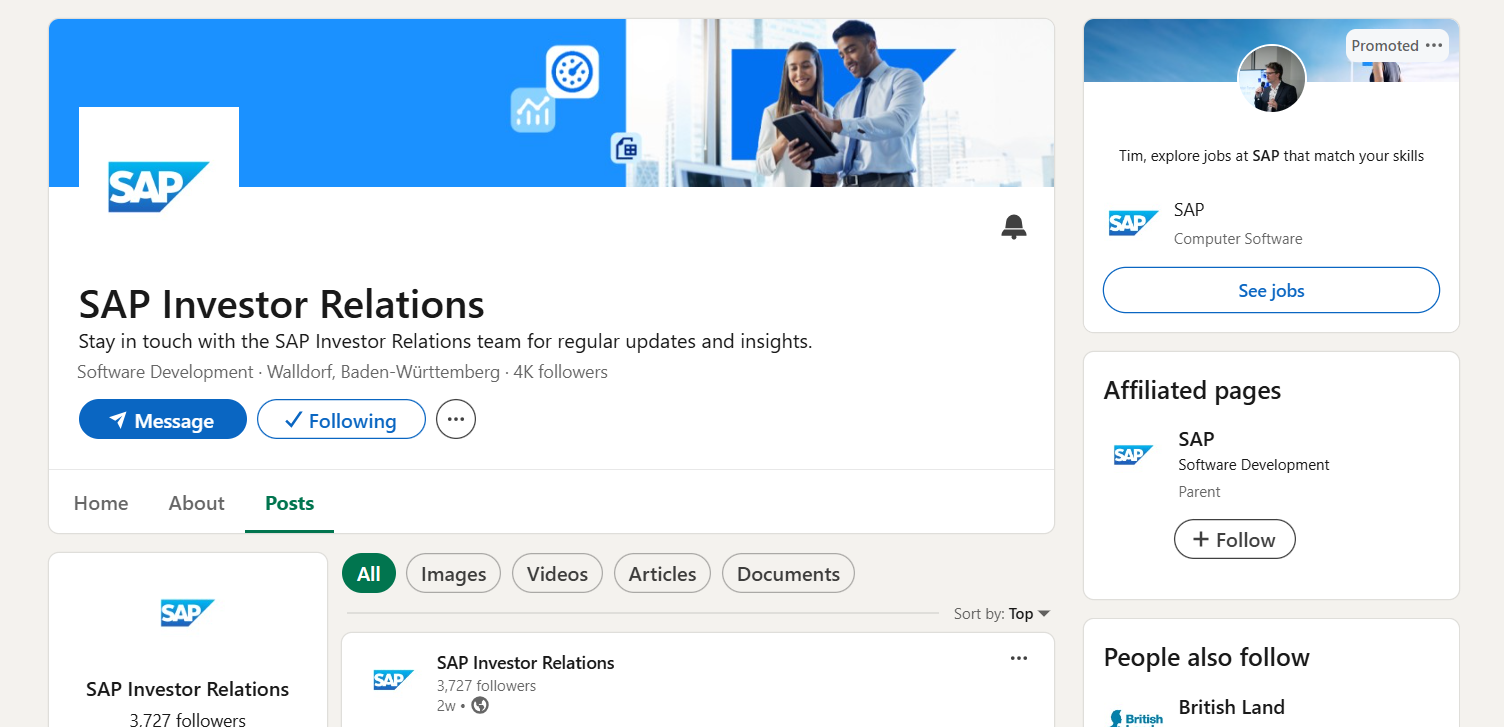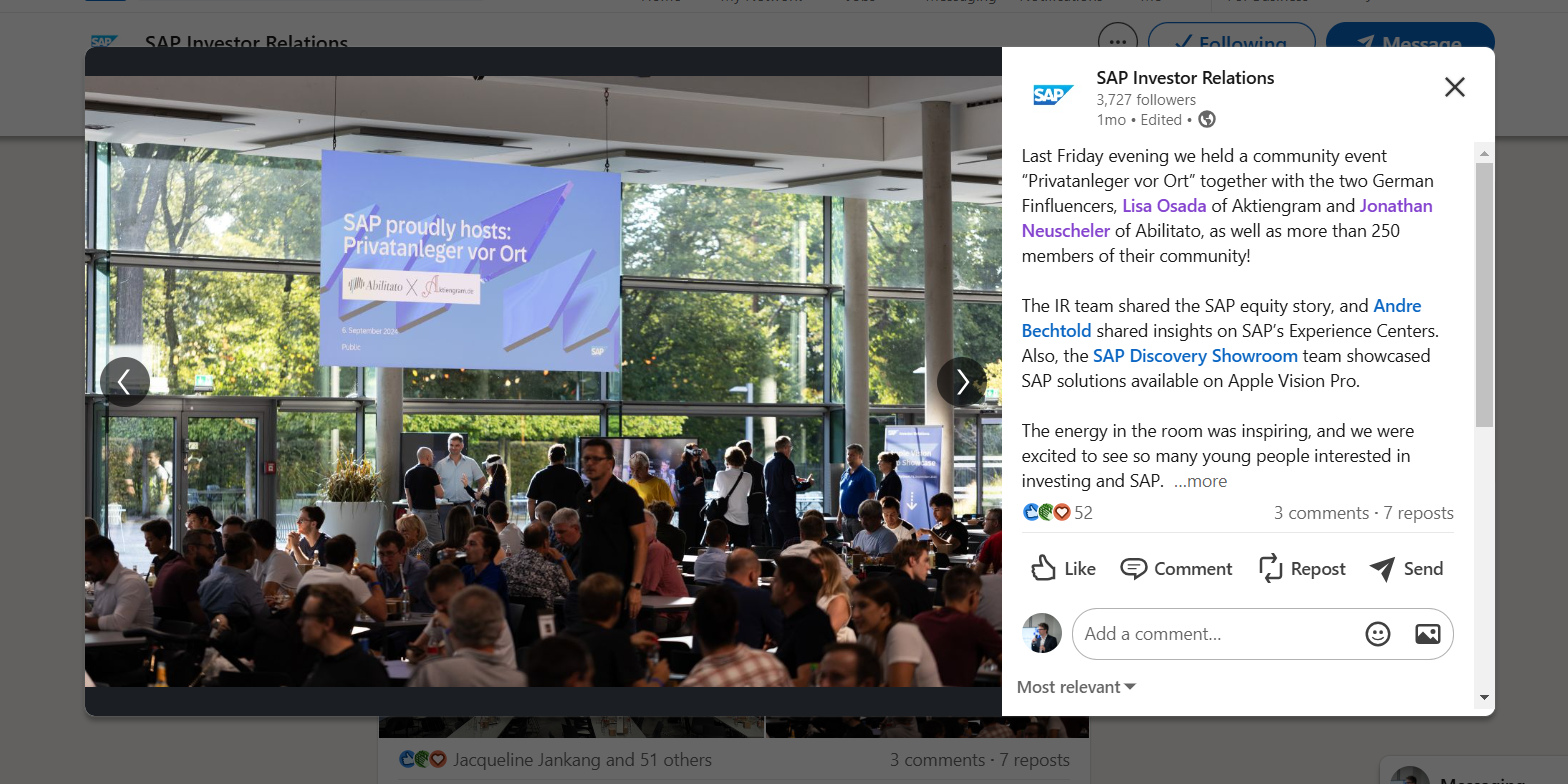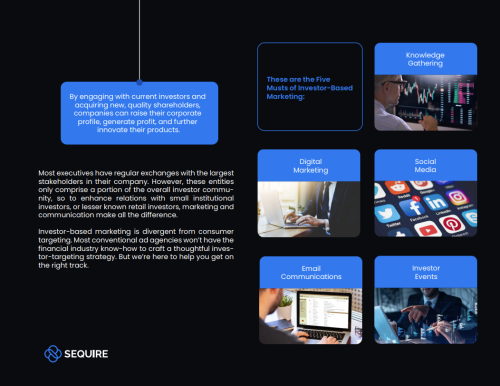‘Beat and raise is back!’ posted Johannes Buerkle, IR officer at German tech giant SAP, on his personal LinkedIn page following the company’s impressive third quarter results in October.
The note was part of a ‘communications cascade’ on the professionally focused social media network, says Buerkle, which helped to amplify the original message. Executives and other IR team members shared similar, personal-sounding updates alongside it.
It all underlines the considered approach SAP takes to digital IR, which includes a dedicated LinkedIn channel, the use of finfluencers and a premium website experience. ‘We're working on this constantly,’ says Buerkle. ‘You have new cohorts of people investing in you, or who want to invest in you, and you need to know how to approach them properly.’
There has been some debate over the years about which social media channels are best for investor relations. SAP has put its chips firmly on LinkedIn, where the company has run its own IR page since the start of the year.

Previously, SAP had an IR-focused X (formerly Twitter) account, but the decision was made to drop that because 'the community has changed significantly, and the language there is not where we want it to be’, says Buerkle.
The DAX member is one of several German large and mid-cap issuers to set up an IR-specific LinkedIn page — others including DHL Group, Deutsche Telekom and Fresenius, to name a few. The IR teams of these companies frequently get together via the German IR association, DIRK, to share ideas and report on progress.
Launched ahead of fourth quarter earnings in January, SAP’s channel now has around 4,000 followers — a cohort that includes not just investors but also employees and partners. ‘What is important for us is the engagement rate — how many people are using our posts to repost, to like or dislike it, comment on, and so on,’ says Buerkle.
He notes a key aim for the firm's LinkedIn presence is to trigger people to look further into the company’s story. ‘It's kind of a teasing environment from our perspective, because the nature of our content is usually very deep,’ he says. ‘The main source and ultimate destination is our comprehensive IR website.’
One of the benefits of being a larger organization is that SAP can throw some more resources at LinkedIn than smaller companies might be able to: it has a whole team dedicated to its posts, making sure they are brand-compliant and thinking about the best way to entice engagement from the audience.
Like Buerkle, other members of the IR team also use their own page to repost content from the main LinkedIn channel. The official channel‘s aim is to avoid fluffy updates about events or travel and keep the focus on useful content for stakeholders. For example, if an executive appears at an event, they will try to include a quote, video snippet or part of the presentation. ‘This is much more beneficial for the reader… than saying we had a good time,’ he says.

Another focus for SAP is reaching the next generation of investors — and to do that, it is considering other social media channels, although not necessarily via an official IR page.
‘Instagram is a very prominent channel, especially for the younger cohorts, but we have not made up our minds whether we are going to set up an IR channel on Instagram as well,’ says Buerkle. ‘It would eat up a lot of resources — you need to have a much higher frequency [of posts], you need to do much more video content and so on.
‘We'd rather look for solutions like identifying trustworthy finfluencers that are coming up and looking for corporates they would like to talk to. It's… important to understand who are the current and future multipliers for our messaging.’
Buerkle says there is a lot of potential in the finfluencer community but the trick is identifying the right individuals to connect with. ‘This is a challenge, because anyone could declare himself or herself a finfluencer,’ he says. You want to find people with a good reputation, the right level of knowledge and whom you can trust, he explains.
Last month, SAP partnered with two German finfluencers - Lisa Osada of Aktiengram and Jonathan Neuscheler of Abilitato — to run an in-person event for their followers, where the company shared its equity story and answered questions. SAP estimated that these two individuals could help it reach around 50,000 people in the 20-40 year age range, Buerkle explains.
‘We set this event up on Friday evening, when everybody is off work,’ he says. ‘Two days after the official announcement, we had about 250 registrations. It was amazing that we could create such a pull effect. And in the end, 230 showed up.’ The collaboration continues to generate new content, adds Buerkle. Follow up events being organized include a private webinar and podcast appearance for the finfluencers’ own channels.

Looking to the future, Buerkle says there are two digital IR projects in the making. One is the use of avatars — virtual representations of humans — to give presentations in multiple languages. The idea is to have a quick and cost-effective way to present information to website visitors and social media followers, especially retail investors.
‘You can use your presentation and simply translate it from German into English, French or Italian,’ he says. ‘It takes a matter of seconds and then the avatar speaks [in the target language]. And if you have some additional content, like charts, then you can merge this and create a video clip from it. This is something that we are testing at the moment for various content areas.’
The other project is focused on investment professionals. Investors and analysts increasingly demand access to raw data, for example on ESG issues, so SAP is looking at ways to make this information easier to source directly.
‘Many on the buy side demand the core information directly from corporates,’ Buerkle explains. 'It's very important to think about a facility that feeds this need, because they are the ultimate receiver of your information, and they should be treated with a white-glove service.’
Although a leader in digital IR, SAP’s IR team is cautious about how much they use generative AI tools to support their work, notes Buerkle. He says he has seen other IR professionals using ChatGPT to summarize analyst notes, but at SAP they prefer to read through them fully to ensure they cover all the details and understand the analyst's message. AI would also struggle to create the tone that the company wants to use in its messaging, he says.
Where AI is used is via market research platforms that have AI-powered features, says Buerkle. He points out that, as more and more functionality in IR tools makes use of AI technology, we won’t need to keep highlighting what is or isn’t AI-supported. ‘Agents will be a standard part of any software soon,’ he says.










